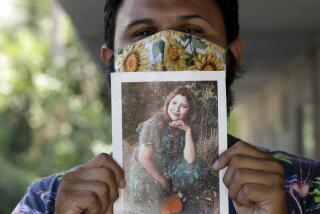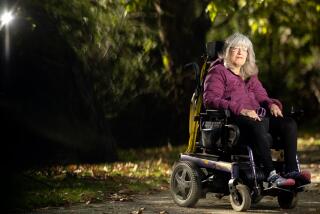$2.4-Billion Dalkon Shield Payout Options Disclosed
Nearly 100,000 women have been notified of their options for collecting from a $2.4-billion trust fund set aside to compensate for injuries caused by the Dalkon Shield birth control device.
Fund trustees said Saturday they hope the distribution plan--mailed to women last week--will mark the final chapter of one of the nationâs largest and most protracted product liability disputes. But some women reacted angrily to the terms and vowed to seek larger settlements.
For the record:
12:00 a.m. March 21, 1990 For the Record
Los Angeles Times Wednesday March 21, 1990 Home Edition Part A Page 3 Column 1 Metro Desk 2 inches; 38 words Type of Material: Correction
Dalkon shield--Women who claim injuries from the use of the Dalkon shield contraceptive device have one year to notify the Dalkon Shield Claimants Trust of the options they have chosen to pursue compensation for their injuries. An article Sunday misstated the time frame.
Under the terms outlined in the letter, women may choose among four options: accept a $725 settlement if they used the Dalkon Shield but have no medical records to support injury claims; be paid up to $5,500 if there was evidence of a medical complication but no proof that the problem was caused by the Dalkon Shield; submit to a detailed medical review if they want to seek a larger settlement; or delay any settlement until more medical evidence in their case is forthcoming.
The distribution arrangement would allow trustees to settle a large number of claims relatively quickly, while reserving the bulk of the fund for severely injured women who have strong medical evidence to back their allegations.
Women have 30 days to inform the trust of the option they choose.
Georgene Vairo, chairwoman of the Dalkon Shield Claimants Trust, said in a statement released Saturday that the trusteesâ decision would finally bring an end to the lengthy dispute.
âAfter too many years, the wheels of justice can begin to turn,â Vairo said. âWomen who were injured by the Dalkon Shield now can select the option that best compensates them for their injuries.â
However, a group of Southern California women who used the birth control device called the payments disclosed by the court-supervised trust fund an insult.
âThis is outrageous,â said Vera Davis, president of the Dalkon Shield Womenâs Support Groupâs Southern California chapter. Davis and about 40 other women met Saturday in a church near the USC campus to discuss their response to the settlementâs terms. The women said they planned a public protest campaign to pressure the trust to change the terms. Approximately 27,000 Southern California women initially claimed Dalkon Shield injuries.
After the notifications arrived in the mail, many women flooded Dalkon Shield hotlines across the country with protests, Davis said. âIâm not going to take it,â said one Los Angeles woman who said she underwent a hysterectomy as a result of using the Dalkon Shield. âFifty-five hundred dollars is not enough. Iâve lost ten years of my life. Iâve had a total of ten operations due to the Dalkon Shield. Fifty five hundred is peanuts,â she told the women gathered Saturday at the Church of God in Christ on South Budlong Street.
A. H. Robins Co. put the intrauterine device on the market in 1971. Within a few years, about 2.2 million women were using the Dalkon Shield. Thousands soon complained of severe pelvic infections and miscarriages and at least 18 women died from complications. Medical researchers concluded that the the tiny string attached to the shield acted as a conduit to spread bacteria from the vagina into the uterus. Robins never acknowledged that its IUD caused problems, but nevertheless took it off the market in 1974.
For years the company tried to contain the mounting litigation, but in 1985 the crush of thousands of multi-million-dollar lawsuits forced Robins to seek protection under the federal bankruptcy code. Robins agreed to the $2.4-billion trust fund and the company was acquired last year by American Home Products.
The U.S. Supreme Court last November declined to hear an appeal contending the $2.4 billion was inadequate. The courtâs decision cleared the way for the distribution of the trustâs assets.
Fund trustees have met with lawyers and claimants during the last year, but the notification, which most women received Friday, is the first time the trust has set out overall ground rules for how the money will be distributed.
The terms of the first option under the plan have been available to some women since December, 1988, but will be offered to other women who filed later claims.
The trust said that Option 2 requires only a limited review of medical records and no specific proof that the Dalkon Shield caused the injuries. Under that option, women would be paid only for the most serious injury they suffered. âYou will not be paid for additional injuries even though you have suffered them,â said a statement in the materials mailed to the women.
For example, according to the letter, a woman who was forced to have a hysterectomy will receive the maximum of $5,500. Infertile women, who did not have surgery, will receive $3,900. Women who had pelvic inflammatory disease will receive $1,250 even if they suffered loss of some organs from the disease.
The second option also provides a series of payments to women for the death of an infant, abortions resulting from complications, and premature deliveries. Children born with birth defects believed to have been caused by Dalkon Shield complications will receive $4,000.
Under the third option, individual settlements will be determined by the trust but women who disagree may go through arbitration or a jury trial. There is no guarantee under Option 3 that women will receive any payment at all and the trust may award less for the same injury than women would obtain under Option 2. âWe believe Option Three should be selected by the claimants who have medical records that prove the Dalkon Shield and no other IUD or medical condition caused serious injury,â Vairo said.
Option 4 allows women to postpone accepting a settlement if they believe they later will have better documentation of medical problems related to the IUD.
Many women at Saturdayâs Los Angeles meetings complained that they have had difficulties obtaining their medical records. Some said doctors and hospitals have been uncooperative for fear that they will be sued because of alleged injuries.
âWe have a big problem with medical records,â Davis said. She said she asked the trust to give special consideration to Southern California women because many received Dalkon Shields through public health clinics that have destroyed medical records.
Another problem, Davis said, is that several Los Angeles hospitals have closed in the last 20 years and those records are lost.
While many women said they were shocked at the payments offered by the trust, some plaintiff lawyers were not. âWe had some inkling of this because the trustees said they wanted to save most of the money for the women who suffered the most. Their theory was that only those women would choose option 3,â said Los Angeles attorney John W. Milton.
âI believe the trust has been unfair,â Milton said. âThey induced women to believe this would be a simple process. Women were led to believe that they wouldnât need a lawyer. They were led to believe that they could just send their medical records under Option 2 and be compensated for whatever injury they had,â Milton said.
Milton said the trustâs announcement will force many more women to apply under Option 3 because âthe figures are so low women canât accept what they are offering.â Unfortunately, he said, many women are in a weak position to file under Option 3 because they are low-income women who canât afford lawyers. Also, he said, many of the injuries these women suffered were compounded by inadequate health care. âThese women suffered from the Dalkon Shield and from low standards of public health care,â he said.
More to Read
Sign up for Essential California
The most important California stories and recommendations in your inbox every morning.
You may occasionally receive promotional content from the Los Angeles Times.










